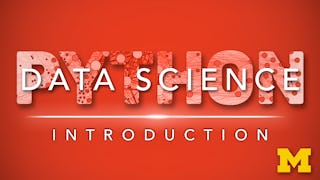In “Data Mining in Python,” you will learn how to extract useful knowledge from large-scale datasets. This course introduces basic concepts and general tasks for data mining. You will explore a wide range of real-world data sets, including grocery store, restaurant reviews, business operations, social media posts, and more.

Get a Black Friday boost with $160 off 10,000+ programs.Save now.


Data Mining in Python
This course is part of More Applied Data Science with Python Specialization

Instructor: Qiaozhu Mei
1,880 already enrolled
Included with 
Recommended experience
What you'll learn
Understand basic concepts, tasks, and procedures of data mining.
Formulate real-world information using basic data representations: itemsets, vectors, matrices, sequences, time series, and networks.
Use data mining algorithms to extract patterns and similarities from real-world datasets.
Calculate the importance of patterns and prepare for downstream machine-learning tasks.
Skills you'll gain
Details to know

Add to your LinkedIn profile
June 2025
20 assignments
See how employees at top companies are mastering in-demand skills

Build your subject-matter expertise
- Learn new concepts from industry experts
- Gain a foundational understanding of a subject or tool
- Develop job-relevant skills with hands-on projects
- Earn a shareable career certificate

There are 4 modules in this course
Welcome to Module 1—an Introduction to Data Mining! We will begin this module with an introduction to the basic concepts, views, and tasks of data mining. We will focus on how to formulate real world information as different data representations (e.g., itemsets, vectors, sequences, time series, networks, data streams, etc.). Then, we will elaborate on two basic functionalities of data mining: patterns and similarity. We will learn how they can be used to build more complex data mining tasks. Let’s get started!
What's included
12 videos9 readings4 assignments1 programming assignment1 discussion prompt
Welcome to Module 2—Mining Itemset Data! In this module, we will learn how to represent data as itemsets and the basic data mining operations with itemset data. We will focus on how to extract frequent patterns from a collection of itemsets, how to evaluate the interestingness of itemset patterns, and how to compute Jaccard similarity between two itemsets. Let’s get started!
What's included
8 videos5 readings5 assignments3 programming assignments
Welcome to Module 3—Mining Vector and Matrix Data! We are halfway through our course on Data Mining! In this module, we will learn in how to mine data represented as vectors and matrices. We will focus on how to represent data as vectors, different similarity/distance metrics of vector data, what are the patterns in matrix data, and how to apply these concepts to real world scenarios. Let’s get started!
What's included
11 videos3 readings6 assignments4 programming assignments
Welcome to Module 4—Mining Sequences, our last course module!! We will conclude our course by learning how to represent data as sequences. We will focus on commonly used sequential patterns (ngrams and skipgrams), distance measures for sequence data (Edit Distance and Shingling), and how they can be applied to real world tasks. Let’s get started!
What's included
10 videos3 readings5 assignments4 programming assignments
Earn a career certificate
Add this credential to your LinkedIn profile, resume, or CV. Share it on social media and in your performance review.
Instructor

Offered by
Explore more from Data Analysis
 Status: Free Trial
Status: Free TrialUniversity of Michigan
 Status: Free Trial
Status: Free TrialUniversity of Michigan
 Status: Free Trial
Status: Free TrialUniversity of Michigan
Why people choose Coursera for their career





Open new doors with Coursera Plus
Unlimited access to 10,000+ world-class courses, hands-on projects, and job-ready certificate programs - all included in your subscription
Advance your career with an online degree
Earn a degree from world-class universities - 100% online
Join over 3,400 global companies that choose Coursera for Business
Upskill your employees to excel in the digital economy
Frequently asked questions
To access the course materials, assignments and to earn a Certificate, you will need to purchase the Certificate experience when you enroll in a course. You can try a Free Trial instead, or apply for Financial Aid. The course may offer 'Full Course, No Certificate' instead. This option lets you see all course materials, submit required assessments, and get a final grade. This also means that you will not be able to purchase a Certificate experience.
When you enroll in the course, you get access to all of the courses in the Specialization, and you earn a certificate when you complete the work. Your electronic Certificate will be added to your Accomplishments page - from there, you can print your Certificate or add it to your LinkedIn profile.
Yes. In select learning programs, you can apply for financial aid or a scholarship if you can’t afford the enrollment fee. If fin aid or scholarship is available for your learning program selection, you’ll find a link to apply on the description page.
More questions
Financial aid available,


